DAC3-04M
Digital-to-analog converter, 4 outputs
Overview of devices
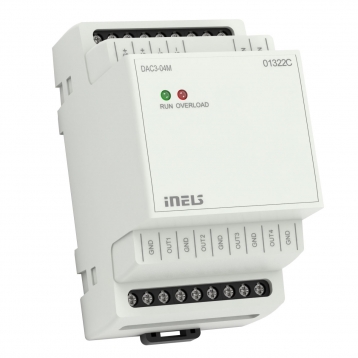
Key Features
DAC3-04M is a converter from a digital signal to an analog voltage signal.
Analog Voltage Output: Generates four analog voltage signals. Output voltage can be operated within the range of 0-10 V or 1-10 V, depending on the type of controlled device.
Device Compatibility: Suitable for regulating and controlling devices such as dimmable ballasts for fluorescent lamps, e.g., LED panels from the assortment of ELKO Lighting, dimming actuators for LED and RGB strips RFDA-73M/RGB, thermo drives, servo drives, and other measuring and regulation elements.
Output Voltage Range Adjustment: The range of output voltage is configurable within iDM3, providing flexibility to adapt to specific device requirements.
Temperature Input: Equipped with a temperature input for connecting a 2-wire external sensor (TC/TZ), enabling temperature-based control or monitoring functionalities.
Modular Design: DAC3-04M 3-MODULE version is designed for mounting into a switchboard, facilitating easy integration into existing setups using DIN rail EN60715.
Exemplary circuit diagram/ Wiring Diagram
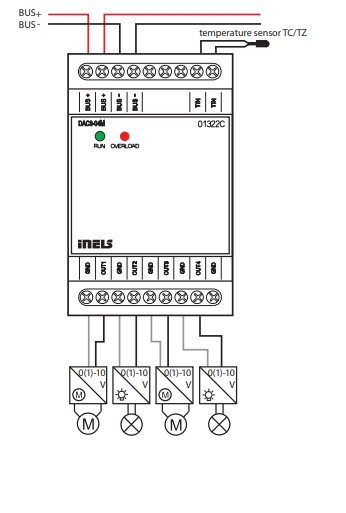
Compatibility chart ( CU, minimal FW version and Integration)
1
CU3-01M
01.3A.00
NA
NA
2
CU3-02M
01.3A.00
NA
NA
3
CU3-07M
02.A0.00
Yes
Yes
4
CU3-08M
02.A0.00
Yes
Yes
6
CU3-09M
Preparation
Preparation
Preparation
7
CU3-10M
Preparation
Preparation
Preparation
Programming in iDM
Introduction
iNELS Design Manager, or IDM3, is for programming iNELS units. This software serves as the platform for configuring device parameters, defining functions, and executing the programming required for iNELS units.
Device parameters, such as sensor range and thresholds, backlights, and operational modes, can be easily adjusted within the IDM3.
The process of programming in IDM3 typically involves defining functions and establishing logical connections between different devices. This allows for the creation of automation scenarios and the implementation of intelligent control strategies.
Starting up
Select the "blue control icon" as shown in Fig 1 > Clicking on the option "New project from default template“ allows you to create a new project from a predefined template.
Select the "Device manager" (Fig 1)> Add "New unit "> Select the central unit > Add "New unit">Select the "Internal-Master/ BUS"> Add "New unit "> Add the devices> Click on the devices to see the "Parameters".

Parameters: Parameters in the iNELS devices refer to the measurable factors or characteristics that define the behavior or performance of the device. These could include electrical properties, physical dimensions, environmental conditions, and various other specifications depending on the type of device.
These are settings specific to individual devices within your automation system.The specific parameters of the DAC3-04M in the iDM as shown in Fig.2
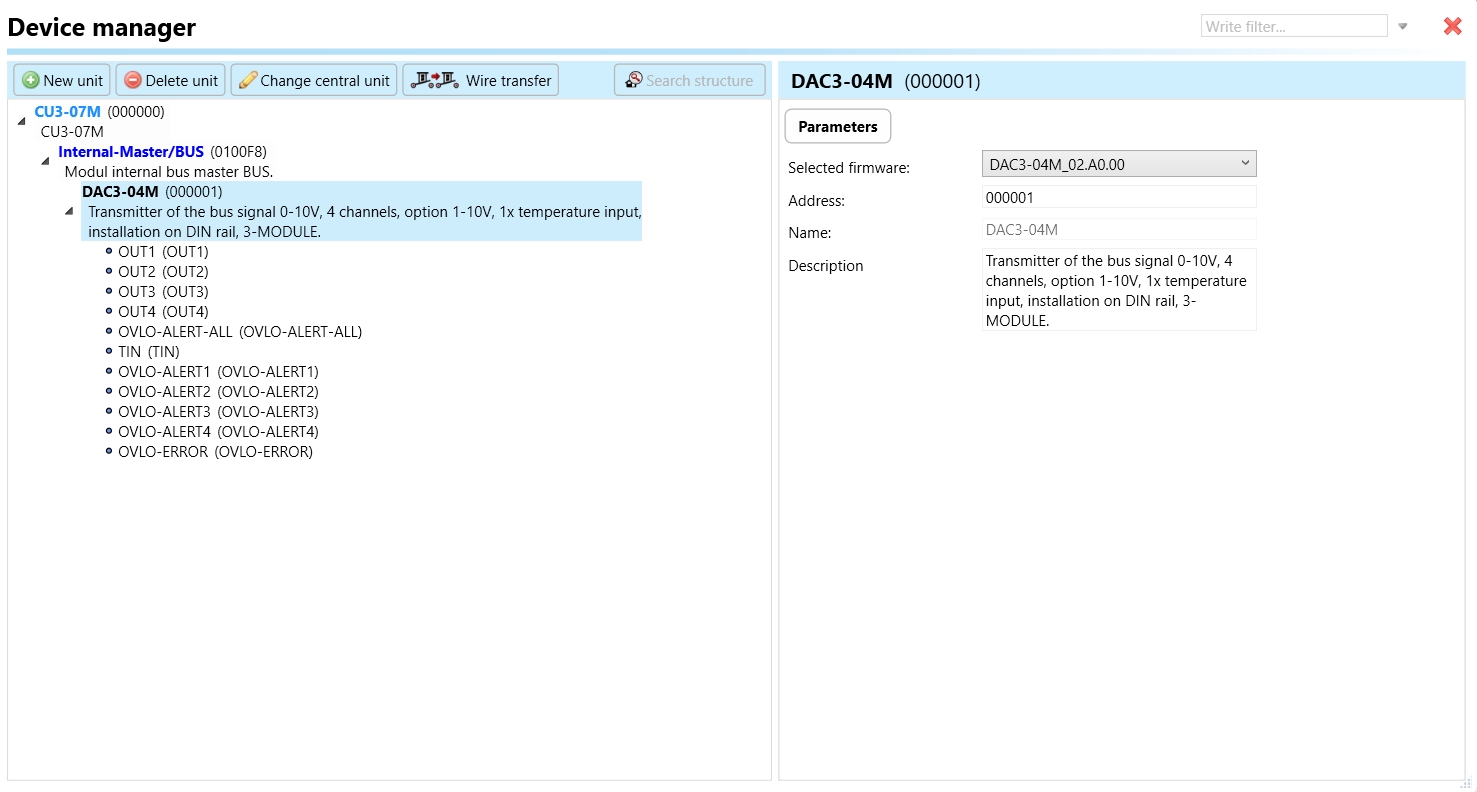
Clicking on the DAC3-04M (Fig.2), will navigate to the selected firmware, address, name, and description, along with other parameters as described below :
OUT 1-4 (Analog Voltage Outputs 1-4): OUT 1-4 represents the four analog voltage output channels of the DA3-04M converter. These channels generate analog voltage signals used for regulating and controlling various devices within the iNELS system.
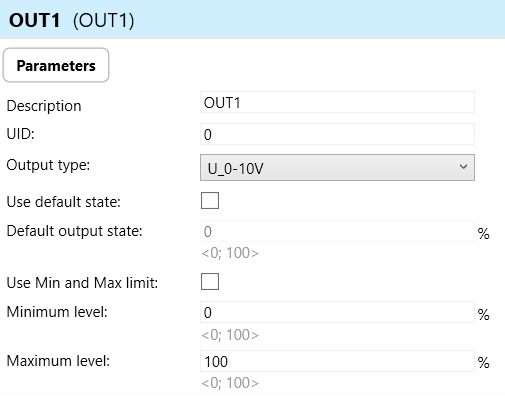
Output Type: Specifies the type of analog voltage output signal generated by each output channel (e.g., 0-10 V or 1-10 V).

Use Default State: In the context DAC3-04M, the term "default state" pertains to the pre-established or initial condition that the actuator adopts in the absence of communication from the bus or central unit. Enabling this function ensures that the relay automatically assumes its default state, which is set to OFF.
Default Output State: Upon choosing the "use default state" option, you will be prompted to specify the default output state. This refers to the pre-established or initial condition that the converter adopts when there is no communication from the bus stop or central unit. Upon selecting this function, the relay will transition to its default output state, which, in this case, is set to ON.
Use Min and Max Limit: Determines whether to utilize minimum and maximum voltage limits for each output channel to ensure safe operation and prevent overvoltage conditions.
Minimum Level: Sets the minimum allowable voltage level for each output channel, ensuring that the output voltage does not fall below this threshold.
Maximum Level: Sets the maximum allowable voltage level for each output channel, ensuring that the output voltage does not exceed this threshold.
OVLO-ALERT-ALL: OVLO-ALERT-ALL parameter indicates the alert status for all output channels of the converter. This alert activates when an overload condition is detected across any of the output channels.
TIN (Temperature Input): TIN parameter refers to the temperature input of the DAC3-04M converter. Used for connecting a 2-wire external temperature sensor (TC/TZ) for temperature-based control or monitoring.
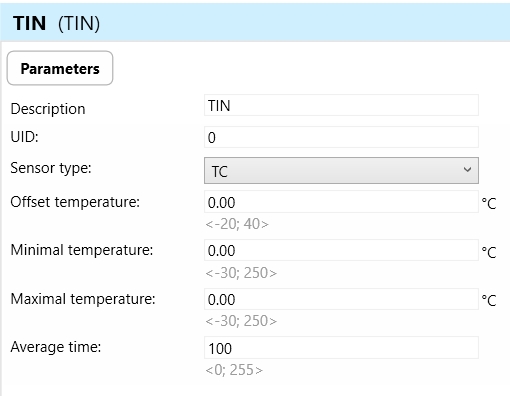
Sensor Type: Specifies the type of temperature sensor connected to the TIN input (e.g., TC, TZ).

Offset Temperature: Offset Temperature parameter allows for calibration adjustments to compensate for any inherent temperature offset in the connected sensor.
Minimal Temperature: Sets the minimum allowable temperature threshold for accurate measurement or control purposes.
Maximal Temperature: Sets the maximum allowable temperature threshold for accurate measurement or control purposes.
Average Time: The average time parameter defines the period over which multiple temperature readings are averaged to obtain a stable and accurate measurement. This parameter helps reduce noise and fluctuations in temperature readings, ensuring precise control or monitoring.
OVLO ALERT 1-4: OVLO ALERT 1-4 parameters denote the alert status for each output channel of the converter. These alerts activate when an overvoltage condition is detected on the respective output channel.
OVLO-ERROR : The OVLO-ERROR parameter indicates the occurrence of an overload error within the DA3-04M converter. This error is triggered when the converter detects an overload condition across any of its output channels, requiring attention or corrective action.
Exports for iNELS Cloud and APP
Setting Up Control and Monitoring for iNELS Cloud and iNELS App
It is possible to control and monitor all the bus units in the iNELS cloud and iNELS app. There are two stages to set up this function. Stage one is to do configuration in iDM3 and stage 2 is to do Configuration in iNELS cloud page and iNELS app.
Configuration in iDM3.
1. Unit and Parameter Selection:
Begin by accessing the iDM3 interface on your PC connected to CU. Navigate to the Device Manager section and carefully select the units and parameters you wish to control. This step is essential for determining what gets exported to the iNELS cloud and app.
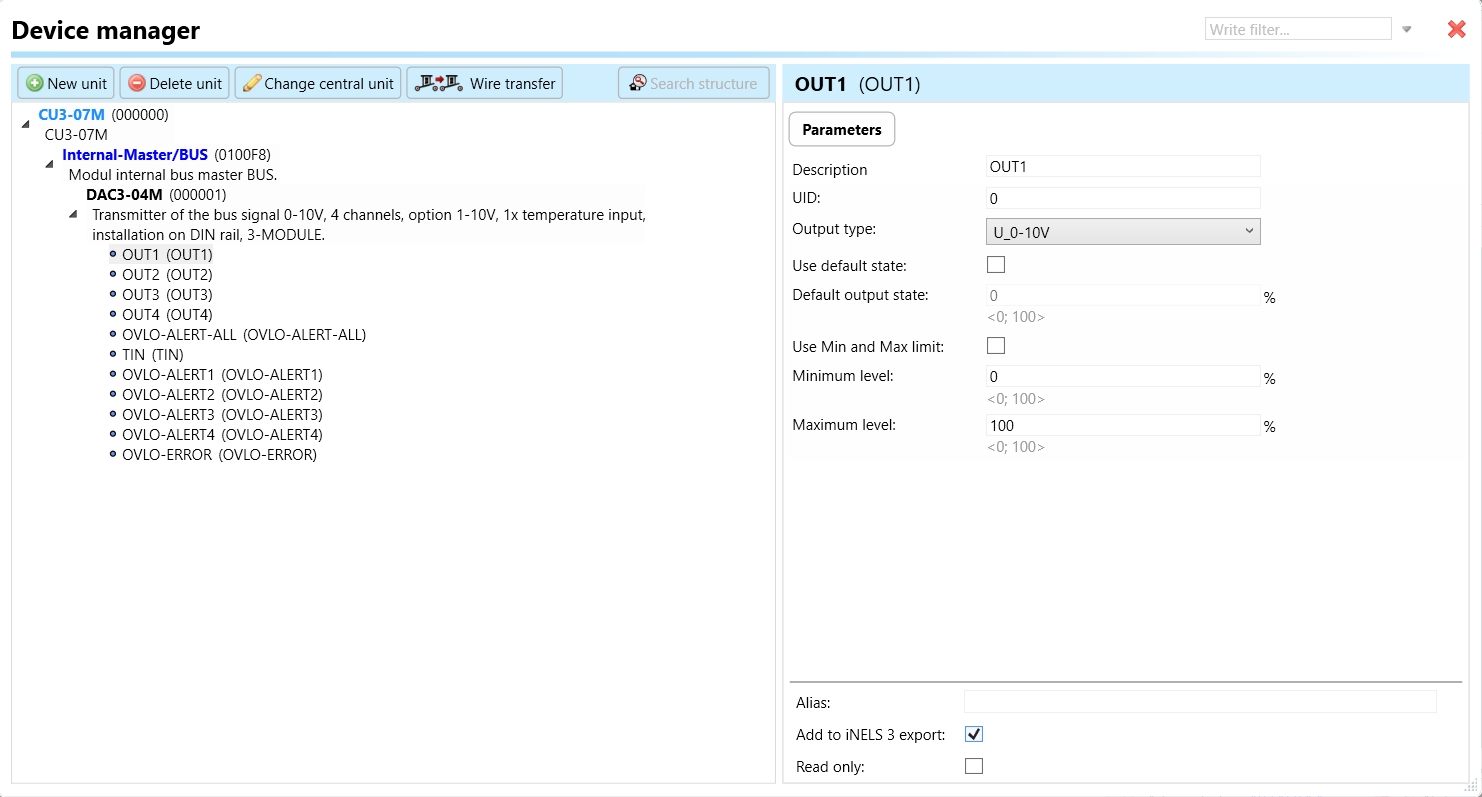
2. CU Configuration and Third-Party Settings :
After the above step, go to the CU configuration in the iDM3, and select the page for third-party settings.
Inside the third-party settings page, designate the port for cloud connection. Set the mode of operation and choose the numerical system as hexadecimal. Pay close attention to verifying and configuring all essential parameters for successful cloud export.
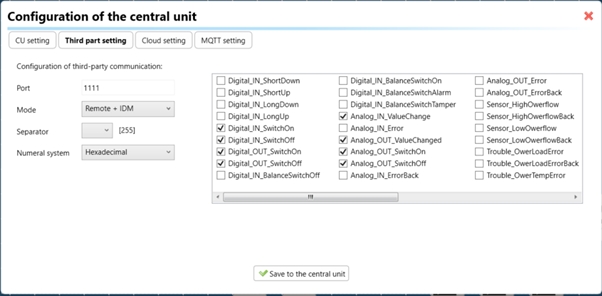
3. Cloud Settings:
Move on to the Cloud Settings section within iDM3.
Input the details of your iNELS cloud account. If you haven't created one, utilize the "New User" tab on the iNELS Cloud web page to establish a free account. (Inels Cloud - ElkoEP).
Select the mode and input the cloud account credentials. Save the project to the central unit to generate and store the export project file in the iNELS cloud account.
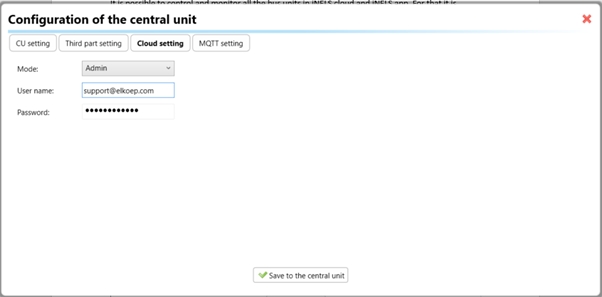
Configuration in iNELS cloud page and iNELS App.
1. Online Status Verification:
Once the cloud credentials and export settings in iDM3 are configured successfully, check the iNELS cloud account's Gateway section. Confirm that the Central Unit (CU) is online and that the export file has been automatically sent to the cloud under your account.

2. Device Creation in Cloud Platform:
In the cloud platform, you have to create new devices in order to control it remotely.
In the device tab, you will find the add device button, which can be used to associate export elements from IDM with the required types and icons.

After entering any name of the device, you select the icon, the MAC address of the communication gateway (in this case CU3), a specific type of device and the address of a specific function and element from the iNELS BUS system.
Note: In order to be able to use the iNELS application for communication with CU3 over the local network or the cloud, it is necessary to create a configuration on the website.
Follow these steps meticulously to ensure a seamless configuration process for controlling and monitoring all bus units through iNELS cloud and iNELS app.
3rd Party Integration with iNELS BUS
3rd Party Integration (MQTT)
iNELS units support MQTT integration on central units CU3-07M, CU3-08M, CU3-09M, and CU3-10M. It is necessary to select the devices and parameters for 3rd party integration on the device manager in the iDM.
Please note that you have an MQTT broker (local or cloud) running in the installation for this integration.
After you have a working MQTT broker you need to configure iNELS Central units to communicate with it. If you have no knowledge of what MQTT is, you can learn about it from MQTT Essentials articles. https://www.hivemq.com/mqtt/
There is a pre-installed MQTT broker in the iNLES bridge, it can be used to connect the iNELS Central units for integration in your projects.
Configuration in iDM3: Select units of 3rd Party integration.
Unit and Parameter Selection:
Begin by accessing the iDM3 interface on your PC connected to CU. Navigate to the Device Manager section and carefully select the units and parameters you wish to control. This step is essential for determining what gets exported to the 3rd party integration via MQTT.
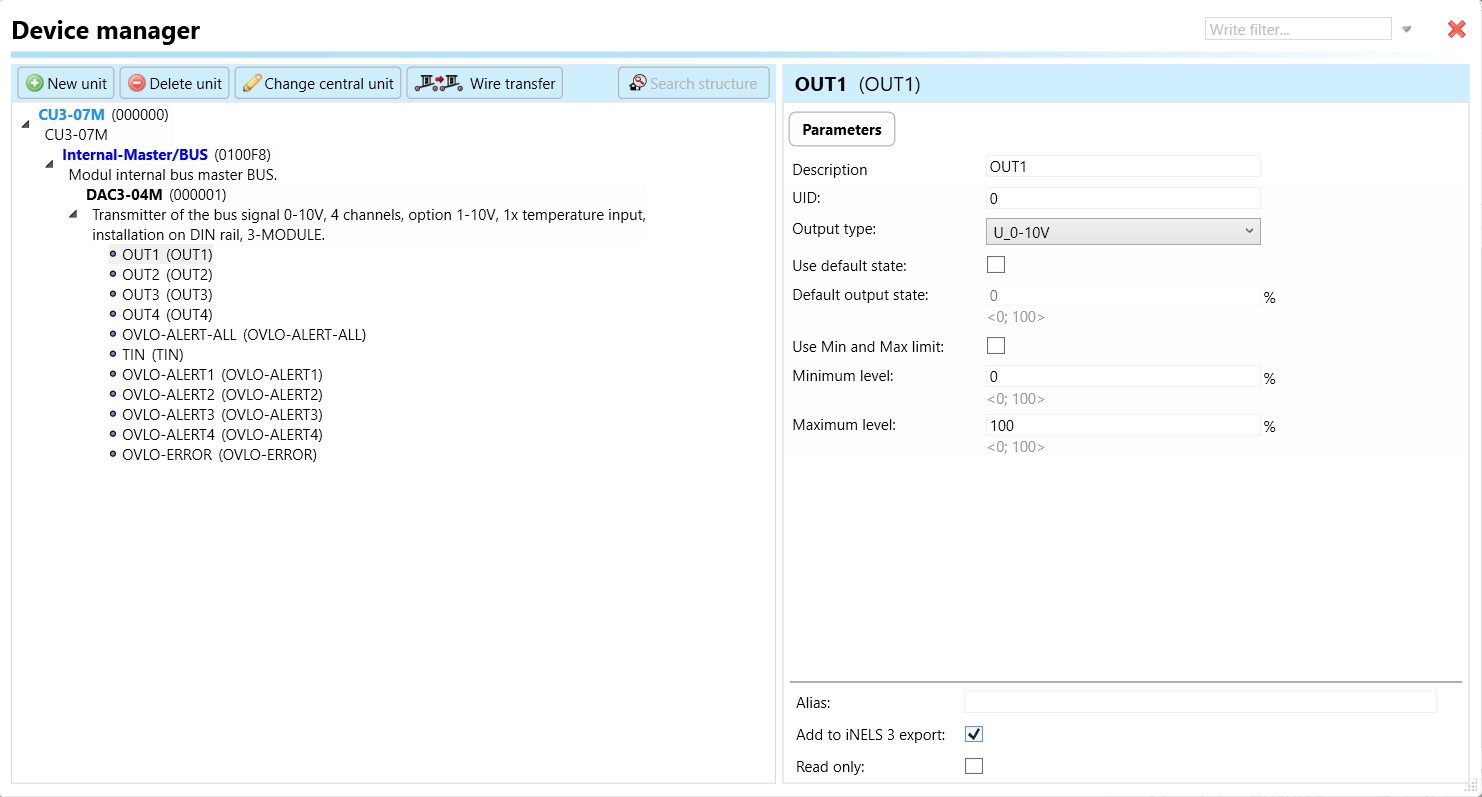
2. CU Configuration and Third-Party Settings :
After the above step, go to the CU configuration in the iDM3, and select the page for third party settings.
Inside the third-party settings page, designate the port for third-party connection. Set the mode of operation and choose the numerical system as hexadecimal. Pay close attention to verifying and configuring all essential parameters for successful third-party integration.

3. MQTT Settings:
Move on to the MQTT Settings section within iDM3.
Input the details of your MQTT broker.
Select the mode and input the broker credentials such as IP, port username and password. Save the project to the central unit.
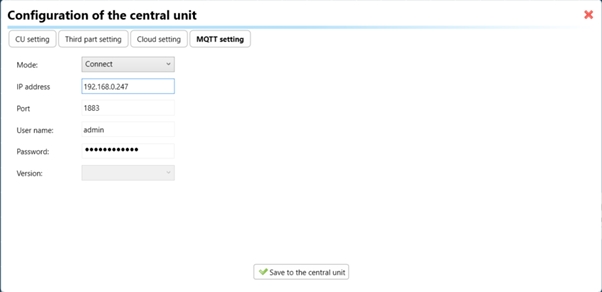
MQTT payload
Appendices
Last updated